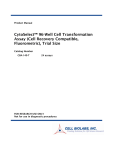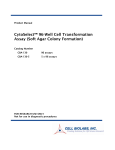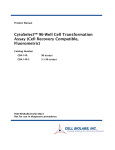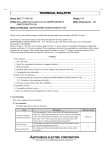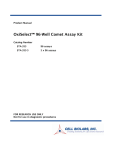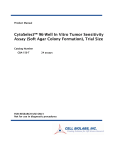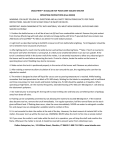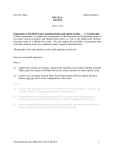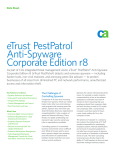Download CytoSelect™ 384-Well Cell Transformation Assay
Transcript
Product Manual CytoSelect™ 384-Well Cell Transformation Assay (Fluorometric) Catalog Number CBA-145 384 assays CBA-145-5 5 x 384 assays FOR RESEARCH USE ONLY Not for use in diagnostic procedures Introduction Neoplastic transformation occurs via a series of genetic and epigenetic alterations that yield a cell population that is capable of proliferating independently of both external and internal signals that normally restrain growth. For example, transformed cells show reduced requirements for extracellular growth promoting factors, are not restricted by cell-cell contact, and are often immortal. Anchorage-independent growth is one of the hallmarks of transformation, which is considered the most accurate and stringent in vitro assay for detecting malignant transformation of cells. Traditionally, the soft agar colony formation assay is a common method to monitor anchorageindependent growth, which measures proliferation in a semisolid culture media after 3-4 weeks by manual counting of colonies. Standard soft agar assays are usually performed in 100-mm or 60 mm dishes, where cells are allowed to grow inside a semisolid culture media for 3-4 weeks before sizable colonies appear. This method is quite cumbersome, time-consuming, and difficult when testing a large number of samples. Additionally, the manual counting of colonies is highly subjective; with varying colony sizes, it’s difficult to determine meaningful results. The CytoSelect™ 384-well Cell Transformation Assay does not involve subjective manual counting of colonies or require a 3-4 week incubation period. Instead cells are incubated only 68 days in a proprietary semisolid agar media before being lysed and detected by the patented CyQuant® GR Dye in a fluorescence plate reader (see Assay Principle below). This format provides a quantitative, high-throughput method to accurately measure cell trans-formation, while the short incubation time makes it possible to assay cells transiently transfected with oncogenes or siRNA. The CytoSelect™ 384-well Cell Transformation Assay provides a stringent, anchorageindependent model for measuring in vitro drug sensitivity and screening cell transformation inhibitors. Each kit provides sufficient quantities to perform 384 tests in a 384-well plate. 2 Assay Principle Related Products 1. CBA-100: CytoSelect™ 24-Well Cell Migration Assay (8μm, Colorimetric) 2. CBA-106: CytoSelect™ 96-Well Cell Migration Assay (8µm, Fluorometric) 3. CBA-106-C: CytoSelect™ 96-Well Cell Migration and Invasion Assay (8µm, Fluorometric) 4. CBA-112: CytoSelect™ 96-Well Cell Invasion Assay (Basement Membrane, Fluorometric) 5. CBA-130: CytoSelect™ 96-Well Cell Transformation Assay (Soft Agar Colony Formation) 6. CBA-135: CytoSelect™ Cell Transformation Assay (Cell Recovery, Colorimetric) 7. CBA-140: CytoSelect™ 96-Well Cell Transformation Assay (Cell Recovery, Fluorometric) 8. CBA-150: CytoSelect™ In Vitro Tumor Sensitivity Assay 3 9. CBA-155: CytoSelect™ Clonogenic Tumor Cell Isolation Kit 10. CBA-320: CytoSelect™ 96-Well Hematopoietic Colony Forming Cell Assay Kit Components 1. 10X CytoSelect™ Agar Matrix Solution (Part No. 114001): One sterile bottle – 10.0 mL 2. CytoSelect™ Matrix Diluent (Part No. 114501): One sterile bottle – 10.0 mL 3. 5X DMEM Solution (Part No. 114502): One sterile bottle – 10.0 mL 4. 5X Lysis Buffer (Part No. 114503): One bottle – 20.0 mL 5. CyQuant® GR Dye (Part No. 10105): Two tubes – 75 µL each Materials Not Supplied 1. Cells and Culture Medium 2. 37ºC Incubator, 5% CO2 Atmosphere 3. Light Microscope 4. Sterile, 384-well Fluorometer Plate 5. 384-well Fluorometer 6. 37ºC and boiling water baths 7. (Optional) Positive Control cells such as NIH 3T3 (Ras G12V) Storage Store all components at 4ºC until their expiration dates. Preparation of Reagents • 2X DMEM/20% FBS Medium: In a sterile tube, dilute the provided 5X DMEM in sterile cell culture grade water to 2X containing 20% FBS. For example, to prepare a 5 mL solution, add 2 mL of 5X DMEM, 1 mL of FBS and 2 mL of sterile cell culture grade water. Sterile filter the 2X media to 0.2 µm. • 10X CytoSelect™ Agar Matrix Solution: Heat the Agar Matrix Solution bottle to 90-95 °C in a water bath for 30 minutes, or until agarose liquefies (microwaving is optional). Transfer the bottle to a 37 °C water bath for 20 minutes and maintain until needed. Assay Protocol (must be under sterile conditions) I. Preparation of Base Agar Matrix Layer 1. Heat the 10X CytoSelect™ Agar Matrix Solution to 90-95ºC in a water bath for 30 minutes, or until agarose liquefies (microwaving is optional). Transfer the bottle to a 37ºC water bath for 20 minutes and maintain until needed. 2. Warm the 2X DMEM/20% FBS medium (see Preparation of Reagents section) to 37ºC in a water bath. Allow at least 30 minutes for the temperature to equilibrate. 4 3. According to Table 2 (below), prepare the desired volume of Base Agar Matrix Layer in the following sequence: a. In a sterile tube, add the appropriate volume of 2X DMEM/20% FBS medium. b. Next, add the corresponding volume of sterile water. Mix well. c. Finally, add the corresponding volume of 10X CytoSelect™ Agar Matrix Solution. Mix well. Note: The 10X CytoSelect™ Agar Matrix Solution is slightly viscous; care should be taken in accurately pipetting the appropriate volume. 2X DMEM/20% FBS Medium (mL) 4 2 1 Sterile Water 10X CytoSelect™ (mL) Agar Matrix Solution (mL) Total Volume of Base Agar Matrix Layer (mL) 3.2 0.8 8 1.6 0.4 4 0.8 0.2 2 Table 2. Preparation of Base Agar Matrix Layer # of Tests in 384-well Plate (20 µL/test) 400 200 100 4. After mixing, maintain the Base Agar Matrix Layer at 37ºC to avoid gelation. 5. Dispense 20 μL of Base Agar Matrix Layer into each well of a sterile, 384-well fluorometer plate (samples should be assayed in triplicate). Gently tap the plate a few times to ensure the Base Agar Matrix Layer evenly covers the wells. Note: 1) Work quickly with the layer to avoid gelation. Also, try to avoid adding air bubbles to the well. 2) To avoid fast and uneven evaporation that leads to aberrant results, we suggest not using the wells on the plate edge, or filling the edge wells with medium to reduce evaporation. 6. Transfer the plate to 4ºC for 20 minutes to allow the Base Agar Matrix Layer to solidify. 7. Prior to adding the Cell Suspension/Agar Matrix Layer (Section II), allow the plate to warm to room temperature for 30 minutes. II. Addition of Cell Suspension/Agar Matrix Layer (under sterile conditions) 1. Heat the 10X CytoSelect™ Agar Matrix Solution to 90-95ºC in a water bath for 30 minutes, or until agarose liquefies (microwaving is optional). Transfer the bottle to a 37 ° C water bath for 20 minutes and maintain until needed. 2. Warm the 2X DMEM/20% FBS medium (see Preparation of Reagents section) and CytoSelect™ Matrix Diluent to 37ºC in a water bath. Allow at least 30 minutes for the temperature to equilibrate. 3. Harvest and resuspend cells in culture medium at 0.5 - 5 x 105 cells/mL. Keep the cell suspension warm in a 37ºC water bath. 5 4. According to Table 3 (below), prepare the desired volume of Cell Suspension/Agar Matrix Layer in the following sequence: a. In a sterile tube, add the appropriate volume of 2X DMEM/20% FBS medium. b. Next, add the corresponding volume of CytoSelect™ Matrix Diluent. Mix well. c. Next, add the corresponding volume of 10X CytoSelect™ Agar Matrix Solution. Mix well. d. Finally, add the corresponding volume of cell suspension. Mix well. Note: The CytoSelect™ Matrix Diluent and 10X CytoSelect™ Agar Matrix Solution are slightly viscous; care should be taken in accurately pipetting the appropriate volumes. 2X DMEM/20% FBS Medium (mL) 7.5 3.75 1.875 CytoSelect™ Matrix Diluent (mL) 10X Cell Total Volume of CytoSelect™ Suspension Cell Suspension/ Agar Matrix (mL) Agar Matrix Solution (mL) Layer (mL) 5.9 1.6 1 16 2.95 0.8 0.5 8 1.475 0.4 0.25 4 Table 3. Preparation of Cell Suspension/Agar Matrix Layer # of Tests in 384-well Plate (40 µL/test) 400 200 100 5. After mixing, incubate the Cell Suspension/Agar Matrix Layer at room temperature for 5 minutes. 6. Immediately dispense 40 μL of Cell Suspension/Agar Matrix Layer into each well of the tissue culture plate, already containing the Base Agar Matrix Layer (Section I). Notes: • Work quickly with the layer to avoid gelation, but gently pipette as not to disrupt the base layer integrity. Also, try to avoid adding air bubbles to the well. • Always include negative control wells that contain no cells in the Cell Suspension/Agar Matrix Layer. 7. Transfer the plate to 4ºC for 10 minutes to allow the Cell Suspension/Agar Matrix Layer to solidify. 8. Allow the plate to warm to room temperature for 30 minutes. 9. Add 20 μL of culture medium containing cell growth activator(s) or inhibitor(s) to each well. 10. Incubate the cells for 6-8 days at 37ºC and 5% CO2. Examine the colony formation under a light microscope. 6 III. Quantitation of Anchorage-Independent Growth 1. Prepare sufficient 5X Lysis Buffer/CyQuant® GR dye solution for all samples by diluting the dye 1:60 in 5X Lysis Buffer (for example, add 10 µL dye to 590 µL of 5X Lysis Buffer). 2. Add 20 µL of 5X Lysis Buffer/CyQuant® GR dye solution to each well. Incubate the plate at room temperature for 30 minutes. 3. Pipette each well 7-10 times to ensure a homogeneous mixture. 4. Read the plate in a 384-well fluorometer using a 485/520 nm filter set. Cell Dose Curve (optional) 1. Heat the 10X CytoSelect™ Agar Matrix Solution to 90-95ºC in a water bath for 30 minutes, or until agarose liquefies (microwaving is optional). Transfer the bottle to a 37 ° C water bath for 20 minutes and maintain until needed. 2. Warm the 2X DMEM/20% FBS medium (see Preparation of Reagents section) and CytoSelect™ Matrix Diluent to 37ºC in a water bath. Allow at least 30 minutes for the temperature to equilibrate. 3. Harvest and resuspend cells in culture medium at 1 - 5 x 106 cells/mL. 4. Prepare a serial 2-fold dilution in culture medium, including a blank without cells. 5. Transfer 20 µL of each dilution to a 384-well fluorometer plate. 6. According to Table 4 (below), prepare the desired volume of Cell Dose Curve Solution in the following sequence: a. In a sterile tube, add the appropriate volume of 2X DMEM/20% FBS medium. b. Next, add the corresponding volume of sterile water. Mix well. c. Next, add the corresponding volume of CytoSelect™ Matrix Diluent. Mix well. d. Finally, add the corresponding volume of 10X CytoSelect™ Agar Matrix Solution. Mix well. Note: The CytoSelect™ Matrix Diluent and 10X CytoSelect™ Agar Matrix Solution are slightly viscous; care should be taken in accurately pipetting the appropriate volumes. 2X DMEM/20% FBS Medium (mL) 1.0 0.5 Sterile Water (mL) CytoSelect™ Matrix 10X CytoSelect™ Diluent (mL) Agar Matrix Solution (mL) 0.315 0.485 0.2 0.158 0.242 0.1 Table 4. Preparation of Cell Dose Curve Solution 7 Total Volume of Cell Dose Curve Solution (mL) 2.0 1.0 7. Immediately dispense 60 µL of Cell Dose Curve Solution into the wells of the 384-well plate, already containing the cell serial dilution (from step 5). 8. Prepare sufficient 5X Lysis Buffer/CyQuant® GR dye solution for all samples by diluting the dye 1:60 in 5X Lysis Buffer (for example, add 10 µL dye to 590 µL of 5X Lysis Buffer). 9. Add 20 µL of 5X Lysis Buffer/CyQuant® GR dye solution to each well. Incubate the plate at room temperature for 30 minutes. 10. Pipette each well 7-10 times to ensure a homogeneous mixture. 11. Read the plate in a 384-well fluorometer using a 485/520 nm filter set. Example of Results The following figures demonstrate typical results with the CytoSelect™ 384-well Cell Transformation Assay Kit. Fluorescence measurement was performed on SpectraMax Gemini XS Fluorometer (Molecular Devices) with a 485/538 nm filter set and 530 nm cutoff. One should use the data below for reference only. This data should not be used to interpret actual results. 600 600 500 500 100 50 400 RFU RFU 400 150 300 200 0 0 2000 4000 6000 300 200 100 100 0 0 500 1000 1500 2000 2500 0 0 Cells/mL (x 1000) 10000 Cell 20000 30000 40000 50000 Number Figure 1. HeLa Cell Dose Curve. Cervical carcinoma HeLa cells were resuspended at 2.5 x 106 cells/mL and titrated 1:2 in culture medium, followed by addition of Cell Dose Curve Solution, Lysis Buffer, and Cyquant® GR Dye detection (as described in the Cell Dose Section). Results are shown by cell concentration or by actual cell number in CyQuant Detection. 8 800 700 600 RFU 500 400 300 200 100 0 1250 625 313 156 78 0 Cells Seeded/Well Figure 2. Anchorage-Independent Growth of HeLa Cells. HeLa cells were seeded at various concentrations and cultured for 7 days. Cell transformation was determined according to the assay protocol. Figure 3. Colony Formation. HeLa cells were cultured in semisolid agar media, in a 96-well plate. Photograph of cell colonies was taken after a 7-day culture. Calculation of Anchorage-Independent Growth 1. Compare RFU values with the Cell Dose Curve and extrapolate the cell concentration. 2. Calculate the Total Transformed Cell Number/Well Total Transformed Cells/Well = cells/mL x 0.020 mL/well For example: If you extrapolate your RFU value from your cell dose curve and determine you have 500,000 cells/mL in your sample. Total Transformed Cells/Well = 500,000 cells/mL x 0.020 mL/well = 10,000 cells/well 9 References 1. Shin SI, Freedman VH, Risser R, and Pollack R. (1975) Proc Natl Acad Sci U S A. 72:44359. 2. Hahn WC, Counter CM, Lundberg AS, Beijersbergen RL, Brooks MW and Weinberg RA. (1999) Nature 400:464-8. License Information CyQuant® GR Dye is licensed from Molecular Probes (Invitrogen). Warranty These products are warranted to perform as described in their labeling and in Cell Biolabs literature when used in accordance with their instructions. THERE ARE NO WARRANTIES THAT EXTEND BEYOND THIS EXPRESSED WARRANTY AND CELL BIOLABS DISCLAIMS ANY IMPLIED WARRANTY OF MERCHANTABILITY OR WARRANTY OF FITNESS FOR PARTICULAR PURPOSE. CELL BIOLABS’ sole obligation and purchaser’s exclusive remedy for breach of this warranty shall be, at the option of CELL BIOLABS, to repair or replace the products. In no event shall CELL BIOLABS be liable for any proximate, incidental or consequential damages in connection with the products. Contact Information Cell Biolabs, Inc. 7758 Arjons Drive San Diego, CA 92126 Worldwide: +1 858-271-6500 USA Toll-Free: 1-888-CBL-0505 E-mail: [email protected] www.cellbiolabs.com 2006-2011: Cell Biolabs, Inc. - All rights reserved. No part of these works may be reproduced in any form without permissions in writing. 10










